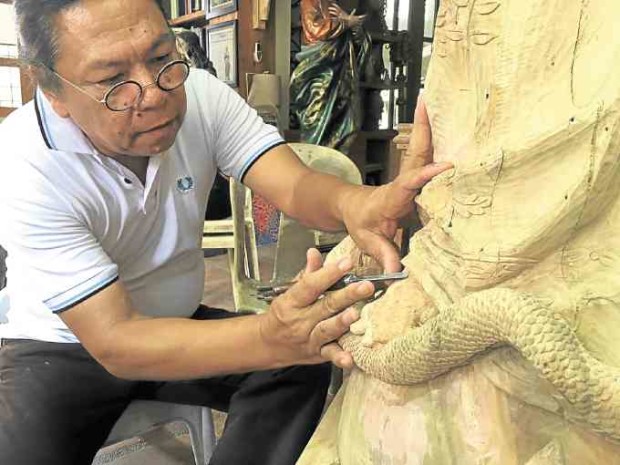Wilfredo Layug: Master of ‘estofado,’ ‘encarna’
Wilfredo Layug, 57, elevated ecclesiastical art in Barangay Sta. Ursula and the rest of Betis by introducing estofado, a tedious painting and gilding process on wooden sculptures, and polychromado (painting the face of a religious figure or encarna).
He applied the techniques as the high point of his apprenticeship under Jose Antonio Navarro Arteaga in Seville, Spain, since 2003.
“Layug is a master not only in sculpturing but in painting. He’s done these in a very realistic way, very artistic. Talagang No. 1 in the country in the arena of ecclesiastical art. A side from [being a] sculptor, he really has the eye for coloring, especially in the handling of gold and silver,” said National Artist for Sculpture Napoleon Abueva.
According to Layug, estofado requires a lot of patience and meticulousness because the wood is “covered by layers of paint that start from putting a primer up to the gilding method.” Antigong tekniko (antique technique) is his other term for this trend.
From afar, estofado gives off the impression that an icon is actually wearing real clothes. The luxurious details of gold are actually the outcome of the careful gilding method.
Abueva said that in applying the new style, Layug has departed from Betis’ traditional wood-sculpting techniques.
Only a few furniture companies, such as Betis Crafts, still use an old gilding method but not in the complicated way of the estofado.
Layug visited Germany, Rome, France, Switzerland, Austria and Poland to analyze styles of retablo (multilevel caverns of images of saints behind the main altar) in European churches.
He learned to carve when he was 8 and went full time at 14. He earned a fine arts degree at University of Santo Tomas by doing woodworks and painting in between. By 1982, he sculpted the wood-relief Matamoros (St. James slaying the Moors) on top of the entrance gate of Fort Santiago.
Layug has done 40 large retablo for cathedrals, including those in the cities of San Jose (Nueva Ecija), and Dagupan and Urdaneta (Pangasinan) and hundreds of smaller ones in parishes throughout the country. He assembled a retablo in a church in Guam recently. He has made about 500 images of mostly big sizes.
The government has conferred on Layug the Presidential Merit Award for Ecclesiastical Art. Pope Francis gave him the “Pro Ecclesia et Pontifice” (For the Church and the Pope) medal in March 2016 for two sets of major works. These are the altar he made for the Pontificio Collegio Filippino in Rome in October 2012 and the seven pieces he crafted for the visit of Pope Francis to the Philippines in January 2015.—TONETTE OREJAS
Juan Culala Flores: From mud to Malacañang
Juan Culala Flores carved the walls, doors and ceilings of Malacañang’s Kalayaan Hall after President Manuel L. Quezon expressed fondness for the life-size bust he made of him.
Flores, born on June 24, 1900, in Purok 2, Sta. Ursula, worked as chief foreman of santo carver Maximo Vicente.
The Center for Kapampangan Studies put up a permanent museum of Flores’ works at Holy Angel University in 2012, simultaneous with his nomination as National Artist.
Flores carved the entrance door of the highly embellished St. James the Apostle Parish, a national cultural treasure, in Betis. He carved Jacob dreaming of a stairway to heaven.
Among his students were Antonio Galleron, National Artist Vicente Manansala, Antonio Dumlao, Bernabe Flores, Ronnie Cruz, Leopoldo Lugine, Alfredo Santos and Allan Cosio.
Flores died in 1992.
